
Recently on Cyclingnews.com |
Tech feature: First ride: Avid Elixir CR, August 7, 2008
Magic potion
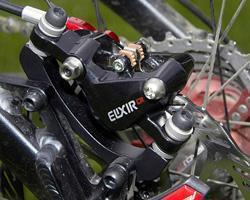
|
The new Avid Elixir hydraulic disc brake platform incorporates some novel technologies and promises some compelling performance but is it the real deal? Cyclingnews technical editor James Huang heads down to the division headquarters in Colorado Springs, Colorado for a first taste test.
Avid's engineers and designers certainly had a daunting challenge in front of them when developing a new brake line to supplement its popular Juicy. At least on paper, they certainly succeeded: according to Avid, Elixir is more powerful yet easier to control, plus 20-30g lighter as compared to a similarly configured Juicy 7. Moreover, its intended usage now spans the full range from cross-country all the way to downhill.
It's what's inside
Elixir isn't an evolution of Juicy as much as it is a wholly new design. The master cylinder boasts a radical new TaperBore internal architecture that should ultimately yield better long-term durability plus the integrated concentric fluid reservoir makes for a tidy appearance. In addition to the tool-free reach adjustment introduced on the Elixir R, the upscale CR comes with an inline pad contact adjustment at the end of the body. Aluminum lever blades are standard but carbon levered versions are on tap as well.
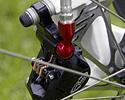
|
The two-piece caliper is all-new as well and the upsized pistons (roughly between Juicy and Code) provide more clamping force. The pads are now top-loaded for easier replacement and the correspondingly bigger caliper window works in conjunction with the grooved piston faces to dissipate more heat. Unlike the standard Elixir R's inline hose attachment, the CR caliper gets a rotatable banjo for more customizable hose routing.
Naturally, Avid has retained its superb CPS arrangement of concave and convex washers for easy installation and adjustments. In answer to some user complaints, Avid has also increased the hardness of the washers to prevent them taking a set.
All told, total claimed weight for the new Elixir CR is a competitive 385g for a complete assembly including a 160mm rotor. Carbon lever blades shed 10g per wheel and sacrificing the adjustable pad contact saves another 10g. Avid will offer 185mm and 203mm-diameter rotors, too, and retail price for the CR is a surprisingly reasonable US$204-212 per wheel, depending on configuration.
Tastes great, less filling
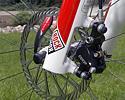
|
We sampled the Elixir CR for two days on the trails surrounding Avid's Colorado Springs headquarters but a few things are obvious even before setting rubber on dirt. One side benefit of the TaperBore architecture is an exceptionally light and snappy lever feel as there is no seal friction until the piston is engaged in the bore. Moreover, the tool-free reach and pad contact adjustments on our Elixir CR test stoppers makes for effortless customization. Twist shifter users in particular will be thrilled; whereas once you had to practically remove the brake lever altogether to access the reach adjustment, now you just have to twiddle a knob. Easy as pie.
Though the fairly wide mix of terrain didn't involve much in the way of ultra-high speed descending where we could really test the ultimate power claims, the widespread deep 'kitty litter' and loose-over-hardpack ground cover required plenty of control and it was here where we noticed some of the biggest differences between Elixir and Juicy.
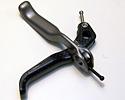
|
Whereas Juicy's power comes on fast and hard and demands a deft touch in such conditions to avoid wheel lockup, Elixir's power is more linear thanks to its slightly revised pivot geometry. The power comes on easy at first and continues to ramp up the harder you pull whereas Juicy's clamping force starts out strong but then seems to level off a bit.
Once we got used to it, all we had to do to scrub a bit of speed was pull the lever and there's absolutely no accompanying drama. Or squealing. Or pulsing. Or any unwanted noise at all for that matter (we were careful to make sure our calipers were well aligned, which is often the cause for many noise issues).
One consequence of that gradual power build-up though, is a slightly softer lever feel as compared to Juicy. The pad contact point is no less obvious but the Elixir lever definitely has a little more 'squish' to it. That being said, any additional lever movement post-contact at least also results in more power.
Two, please
We should take the time to clarify one point here: Avid intends the Elixir as a higher-end supplement to the Juicy line, not a replacement. All of the Juicy models, save for the somewhat redundant Juicy Carbon, will carry on for '09.
While clearly a better performer in nearly every category though, Elixir is also a bit more expensive than its ubiquitous stablemate but not by very much. Juicy is still an excellent performer but based on the modest price difference and our initial impressions of Elixir, those in the market for a high-end hydraulic disc brake would do themselves a big favor by coming up with the extra cash.
What is TaperBore?

|
Virtually every hydraulic disc brake currently on the market uses a similar internal layout: the lever blade is attached to a master cylinder piston that pushes fluid through a straight-walled bore, out along the hydraulic line, then into the caliper body. However, 'timing ports' that connect the piston chamber to the reservoir mean that hydraulic pressure doesn't build (meaning the caliper pistons don't move) until the master cylinder piston cup seal moves past those timing ports and seals the chamber.
Up until that point, the master cylinder piston basically just pushes fluid through the timing ports into the reservoir. This is also the basis for Avid's pad contact adjustment system: by moving the location of the piston relative to the timing ports, you can get more or less lever movement before the timing ports are sealed off (the adjustment does nothing to the location of the pistons and pads in the caliper body).
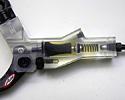
|
TaperBore, on the other hand, is a completely different setup. The fluid reservoir and piston chamber essentially share one big cylindrical space and the piston is free floating through the first part of its stroke; the piston seal doesn't actually contact anything initially which is why the Elixir lever initially feels so light and snappy.
As the piston continues to advance though, the seal enters a tapered section of the internal bore where the diameter necks down. At this point, the piston chamber seals up and pushes fluid through the line. In effect, the taper itself is analogous to the timing ports used on other systems. In the case of Elixir CR, the pad contact adjustment is accomplished by moving the taper location closer to or further away from the piston. Again, this doesn't affect the position of the pads or pistons within the caliper body.
TaperBore definitely has some packaging advantages relative to timing ports in that there it's easier to integrate the reservoir, and likely some manufacturing ones as well since most of the milling work can be done on one axis. For users though, the gains come in long-term durability: the bottom edge of those timing ports is relatively sharp and they will eventually wear grooves in the master cylinder piston cup seal as it repeatedly goes past. TaperBore's master cylinder uses a more durable o-ring and the taper itself is far gentler over time so there shouldn't be as much wear.
Photography
For a thumbnail gallery of these images, click here
Images by James Huang/Cyclingnews.com
- The new Elixir represents Avid's next generation of hydraulic disc brake technology.
- According to Avid, Elixir is lighter, more powerful and easier to control than its ubiquitous Juicy.
- Bigger windows in the new two-piece caliper allow more cooling air to flow through and the top-loaded pads are easier to replace, too.
- The top-end Elixir CR also adds a rotatable banjo for cleaner hose routing.
- Grooved pistons also allow for a bit of cooling air to access behind the pad backing plates.
- The new TaperBore setup makes for a tidier-looking lever assembly.
- The pad contact adjustment feature is now tool-free and neatly integrated into the end of the lever.
- A free-rotating end signals an end to kinked hoses.
- Elixir will be available with either aluminum or carbon lever blades (production models use a unidirectional weave, not 3K).
- Even the corresponding pad spacer blocks have been cleverly designed: use one way to keep the pistons from clamping down during transport, flip around the other way when the pads are removed for bleeding, and yes, there's a bottle opener on the side, too.
- This mural welcomes you as you enter SRAM's Colorado Springs development center.
- Hopefully your brakes never get this hot but rest assured that Avid has looked into what happens to its brakes if they do.
- Even the rotors are subject to fatigue tests.
- Avid engineers are constantly playing with different rotor shapes. Maybe we'll see these someday… or maybe we won't.
- The Colorado Springs center is also home to RockShox and there's an awful lot of history hanging on this wall.
- RockShox's in-house machinists can actually make complete fork lowers from aluminum billet to test a concept. These Totem prototypes once began life as one of the enormous blocks beneath it.
- RockShox test engineers can upload actual ride files to its testing machine. This one was apparently recorded in Steve Peat's backyard.
- Ouch, that hurts! The next time you walk into your shop with a bent fork and claim you were 'just riding along', think again. If this fork can handle this without permanent deformation, chances are you were doing a little more than just riding off curbs.
- Elixir uses an all-new TaperBore internal architecture for its master cylinder design.
Images by SRAM
- Unlike typical hydraulic setups that use a cylindrical bore and perpendicularly oriented timing ports, Elixir uses a step-down tapered bore.
- Pad contact on Avid's other designs is achieved by moving the master cylinder piston relative to the timing ports.
- Standard designs don’t build hydraulic pressure until the piston cup seal moves past the timing port, thus sealing the chamber from the fluid reservoir.
- Juicy is far from dead but we can only wonder how long it'll be before all of Avid's brakes use the TaperBore design.

